2020 marked the 100th anniversary of the founding of Boxoffice Pro. Though the publication you hold in your hands has had different owners, headquarters, and even names—it was founded in Kansas City by 18-year-old Ben Shlyen as The Reel Journal, then called Boxoffice in 1933, and more recently Boxoffice Pro—it has always remained committed to theatrical exhibition.
From the 1920s to the 2020s, Boxoffice Pro has had one goal: to provide knowledge and insight to those who bring movies to the public. Radio, TV, home video, and streaming have all been perceived as threats to the theatrical exhibition industry over the years, but movie theaters are still here—and so are we.
We at Boxoffice Pro are devotees of the exhibition industry, so we couldn’t resist the excuse of a centennial to explore our archives. What we found was not just the story of a magazine, but the story of an industry—the debates, the innovations, the concerns, and above all the beloved movies. We’ll share our findings in this series, A Century in Exhibition.
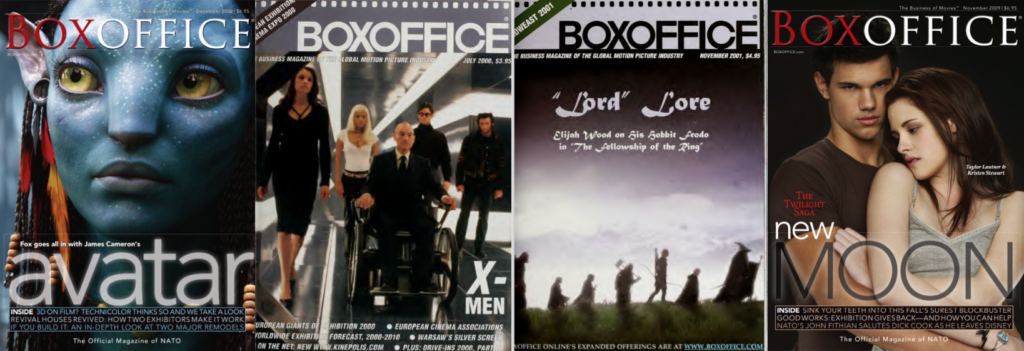
The new millennium marked nothing short of a historic turning point for the exhibition business. Even though exhibition survived Y2K unscathed, its own reckless spending on megaplexes and overbuilding in the 1990s resulted in a series of bankruptcies that cast serious doubts on the industry’s future.
But perseverance and resilience, even during the Great Recession of 2008, proved doomsayers wrong. Exhibitors rebounded and confronted the biggest technological revolution since the advent of sound: digital cinema. The revolution was long and full of turmoil, as technical standards and fair financing for this costly investment became the object of intense debates between exhibitors and studios. During this journey, theater owners ventured into alternative forms of content and devised new revenue channels afforded by digital technologies, with a special interest in preshow digital advertising.
The 2000s were also marked by a strong uptick of interest in another revolutionary tool: the internet. Yet as online ticketing began to reach its full potential and exhibitors slowly discovered the power of social media, new digital platforms and the threats of online piracy created unprecedented challenges that continue to rock the industry today.
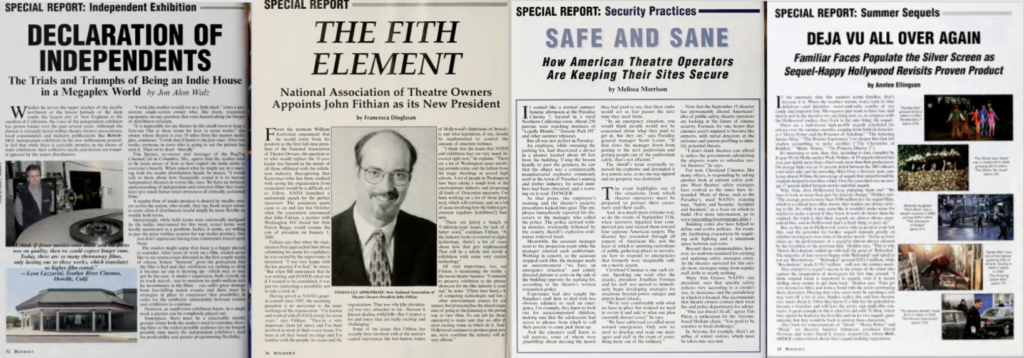
From Boom to Bust to Boom
The megaplex rush of the 1990s proved to be a costly mistake for most of the exhibition industry, driving many theaters to the verge of extinction. As a result of overbuilding, a wave of bankruptcies began in the early 2000s. The fate of United Artists Theatres, one of the biggest circuits in the country, was a scary harbinger: even the exhibition giants, it was feared, were not immune to the bankruptcy trend. In February 2000, the circuit reported a net loss of $25.6 million. By May, the rating agency Moody’s downgraded its public debt while considering doing so for Regal Cinemas, Loews Cineplex, and Carmike Cinemas. Soon after, in September 2000, United Artists sought Chapter 11 protection from its creditors. Silver Cinemas, the parent company of the art house chain Landmark Theatres, preceded it in May of that year, while Carmike Cinemas, which faced $65 million in total debt, and Edward Theatres filed for bankruptcy in August. In October, General Cinema did so as well, abandoning its plans for an art house venture with Sundance Film Centers. The shadow of bankruptcy loomed over even bigger circuits, with many pundits correctly predicting that Regal Cinemas—which would file for Chapter 11 in 2001—was next.
How could an industry that had been so confident in its megaplex strategy just a few years before find itself in such a situation? The problem was simple: exhibitors had cannibalized themselves. In the 1990s, theater chains added screens at a much more rapid pace than their audiences grew. What small gains were made came at the expense of existing theaters, ultimately driving many smaller operators out of business. At the same time, the premiumization of the moviegoing experience associated with the expensive megaplexes drove up the expectations of moviegoers, who then demanded better services. “The thinking was that bigger was better. Huge multiplexes were built in areas that could not support the large number of theaters being built, and smaller mom-and-pops didn’t close down as expected, leaving too many screens open,” explained analyst Wade Holden in April 2003.
Kurt Hall, president and CEO of United Artists Theatre Company, explained in January 2002 that the industry “created a new theatre design called the megaplex that turned out to be a profit eating machine that put existing healthy theatres out of business and changed film release patterns and customer moviegoing habits before an appropriate change in [the] film cost structure was developed.” Indeed, the advent of the megaplex coincided with the practice of “glut booking,” where an extraordinary amount of prints was sent out to theaters, often paired with a rapid playoff—films cycling out of theaters quicker—thus depriving operators of the larger share of box office revenues they would typically get later in a film’s run—that was detrimental to the cinema business model. Hall concluded that the megaplex altered the perception of moviegoing itself: “We, our suppliers, and even our customers began to treat moviegoing as a commodity, rather than a special out-of-home entertainment experience.”
Exhibitors faced other challenges that compounded the overbuilding problem. Activists and Washington brought exhibitors to court over their alleged lack of compliance with the Americans With Disabilities Act (ADA). In a landmark ruling, Cinemark’s stadium seating was found to be ADA compliant by the Supreme Court. Litigation in District Court between AMC and the Justice Department over stadium seating ADA compliance, meanwhile, resulted in a settlement, with AMC agreeing to spend millions to retrofit the theaters cited in the case.
Yet the biggest blow came on September 11, 2001. Immediately after the tragedy, some movie theaters in New York City volunteered to help those in need. The United Artists’ Union Square theater, for instance, “opened its doors to all needing a place to rest, something cool to drink or even an abode for the night, and in those initial days, the theatre provided comfort to more than 16,000 people,” explained editor Kim Williamson in November 2001.
The terrorist attacks raised new questions about the security of movie theaters. Following 9/11, several theaters had to be checked for anthrax or reported bomb threats. Williamson sought to assuage the anxieties of exhibitors and moviegoers by reminding them that “it’s not that we’re not safe; it’s that we’re unsettled, and the situation seems worse because we are accustomed to calm and comfort.” Regardless, many circuits ramped up their security procedures as part of special anti-terrorist measures. New York City–based Loews Cineplex Entertainment introduced restrictions like a ban on backpacks and packages, as well as searches upon entry. Boxoffice Pro began a series of special articles on managing crisis situations and increased its coverage of international terrorism, reporting, for example, the bombing of four Bangladeshi movie theaters in 2003 that resulted in multiple deaths. In November 2001, NATO launched a safety and security training tape series on how to prevent and handle emergencies. Despite the heated conversation about security at the time, the debate faded until it was reignited with more urgency after July 20, 2012, when 12 people lost their lives in a tragic mass shooting at Cinemark’s Century 16 in Aurora, Colorado.
2002 was a very different story. Despite a weak economy and a dismal stock market, exhibition was on its way to recovery. “The year 2002 was an extraordinary one for exhibitors,” wrote Wade Holden, looking back from April 2003. Box office returns set a new record of $9.2 million, and admissions grew 7.4 percent to nearly 1.6 billion, recovering from the dip they took in 2000 that landed them at 1.4 billion. The recovery was boosted in part by a good slate of superhero films and sequels/prequels, including Spider-Man, Star Wars: Episode II – Attack of the Clones, and The Lord of the Rings: The Two Towers.
While most exhibitors continued to close screens, the cash of billionaires like Philip Anschutz—who led a group that acquired majority investments in Regal Cinemas, United Artists Theatres, and Edwards Cinemas and in 2002 consolidated them to form Regal Entertainment Group—contributed to a renaissance. AMC, which managed to avoid the industry’s bankruptcy trend partly thanks to a $250 million cash infusion from Leon Black and his Apollo Management, acquired both General Cinema and Gulf States Theatres in early 2002 and issued an IPO of $100 million. Regal Entertainment Group also pulled off an IPO by putting up 18 million shares of Class A common stock for $19 per share, raising $345 million. As Kim Williamson noted in May 2003, “the clearest sign of how well things are going is who wants to play too—not just how well you know things are going, but how much people elsewhere see how well things are going, and want to be part of the scene. As I write this, Microsoft has pacted with Landmark to make the biggest digital cinema circuit to date; names like NBC and Turner are part of the preshow, and giants like Boeing and TI are parts of the corps; Krispy Kreme even wants to sell donuts at Famous Players.”
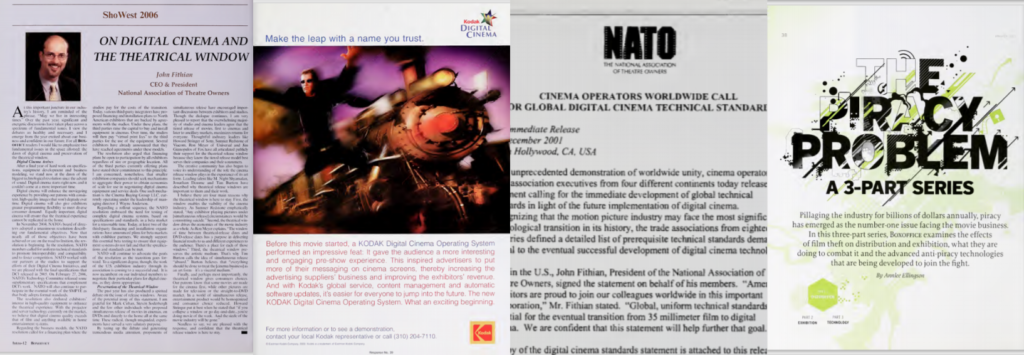
The Long Road to Digital
The interest of outside players was not a coincidence. It was linked to what had seemed like a pipe dream during the bankruptcy boom but was slowly becoming a reality: the digital revolution. In the first years of the decade, the idea of spending upward of $100,000 to retrofit just one screen was nothing more than a fantasy. The beginning of the industry’s financial recovery made that dream just a little more reachable. Meanwhile, the major studios had been moving full steam ahead toward digital since 1999. On June 18, 1999, Texas Instruments’ DLP Cinema projector technology was publicly demonstrated in two screens in Los Angeles and New York City for the release of Star Wars: Episode I – The Phantom Menace. Disney also led the way with Toy Story 2 and Dinosaur. Filmmakers like Mike Figgis enthusiastically embraced the technology.In 2002, Star Wars: Episode II –- Attack of the Clones was released digitally in 17 markets across 94 venues.
On June 6, 2000, digital history was made. For the first time, a feature film was transmitted via the internet from a studio lot in Hollywood to the SuperComm 2000 telecommunications trade show in Atlanta, Georgia. Cisco Systems, Qwest Communications, Sigma Design Group, Barco Digital Projection Systems, and 20th Century Fox partnered to project Fox’s Titan A.E. “The audience loved it,” said digital cinema market manager for Barco Wendy Bosley in Boxoffice Pro. “It’s a great atmosphere, and people were just stunned by the image [and] the quality that the TI projector was able to screen.” Similar partnerships between studios and digital manufacturers, such as America Online and Time Warner and Miramax and Boeing, flourished.
It was in this context that the Digital Cinema Initiatives (DCI) was formed in March 2002. A joint endeavor of Disney, Fox, MGM, Universal, Paramount, Sony, and Warner Bros. aimed at developing a system specification for digital cinemas, it was to become one of the key battlegrounds in the digital revolution, pitting studios against theaters and their representative, NATO.
In 2000, the fan site TheForce.net launched a petition encouraging fans to contact their local cinema managers about the lack of digital system installations in most theaters. The petition named NATO’s new president, John Fithian, as a “major stumbling block” who wasn’t “convinced that digital is worth it.” The petitioners were unaware of the general state of the exhibition industry, which explained the small number of digital screens (just 15 in December 2000) at the time of the petition’s release. They also ignored the many challenges that needed to be resolved before exhibitors could transition to this new technology. “Digital cinema could revolutionize the business by transforming the nature of production, delivery, and exhibition; by saving distributors hundreds of millions of dollars annually; and by making it easier for exhibitors to offer alternative content. None of this will come easy, however. Significant issues and challenges confront the potential transition, not the least of which is the issue of costs. No one knows for sure which technology will prevail, when the transition will occur, nor how it is going to be financed. Nonetheless, the transition will come …” Fithian said at the National Institute of Standards and Technology in April 2001.
The digital transition was inevitable. Already in January 2000, a Boxoffice Pro survey on the state of the industry revealed that for all the exhibitors surveyed, including Bruce J. Olson of Marcus Theatres, Dan Harkins of Harkins Theatres, Bob Babgy of B&B Theatres, and Sheri Redstone of National Amusements, digital cinema was the biggest change facing exhibition in the coming decade. However, the questions of quality, release strategies, security and piracy, standards, and most importantly who would pay for it were far from being resolved. Boxoffice Pro became a forum for these often-heated debates, as theater owners, managers, projectionists, and technology specialists used the publication as a tribune. In April 2000, an exhibitor from Texas wrote a passionate letter to Boxoffice Pro noting the top five reasons not to go digital. Another exhibitor from California responded, concluding that he would “miss the days of holding 35mm in his hand, splicing it and threading it through projectors, but the advantages of digital projection make the moviegoer in [him] very happy.”
Image quality was a top concern for exhibitors. By the beginning of the decade, it had become almost routine for trade shows to display side-by-side screen presentations that juxtaposed images of digital and 35mm movies. A Boxoffice Pro contributor noted that at one such screening at Cine Expo in September 2000, “a suspicious eye may have noted that in some cases … a particularly poor print of the 35mm half was screened to the audience, with jump and scratch in the film markedly notable.”
“Personally, I feel like there is no technology available today that can beat the quality of a properly projected film print,” wrote a former theater manager and projectionist in a letter to Boxoffice Pro in July 2001, echoing a widespread viewpoint. As the technology progressed, however, the quality of digital projection became increasingly equal to or surpassed that of 35 mm film. Another projectionist shared his experience in February 2002, when he watched a digital trailer for Unbreakable: “As soon as I saw Bruce Willis’ flesh tones, I knew that film was dead as a projection medium. … George Lucas was right when he said, ‘I love film but it’s a 19th-century invention.’” Exhibitors were also dreading projection failures and changing release strategies. “Having every theatre in the world playing the exact same titles at the exact same time takes away from the excitement of going to the movies and is more akin to television programming,” complained an exhibitor.
NATO was on the front lines of the digital battle between exhibitors, distributors, and technology companies. At the end of 2001, NATO and 20 of its international counterparts, including UNIC and the Motion Picture Theatre Associations of Canada (MPTAC), sent out a letter addressed to several organizations working on the standardization of digital cinema. The goal was to encourage the development of interoperable yet competitive products while maintaining the relatively low cost of existing film projection systems. The nightmarish transition to digital sound just a few years prior, which led to many incompatible systems competing in the market, could be even more disastrous because of the multitude of different components (encryption, de-encryption, compression, decompression, servers, projectors, etc.) necessary for digital projection. To avoid a monopolized market, standards needed to be set up for all components to properly interact with each other.
In February 2004, DCI’s long-awaited technical specifications draft drew criticism from exhibitors in the U.S. and Europe. In a strongly worded letter, NATO criticized the studio consortium for wanting to weaken security standards to remove exhibitor control over their equipment. A widespread fear, for instance, was that a studio could tamper with the placement of a film in the program and darken the auditorium. NATO issued a resolution in January 2005 that highlighted the demands of exhibitors: “The exhibitors want a branded digital cinema experience that exceeds the quality of 35mm film and home-entertainment systems. They also require open and global technical standards that promote competition and ensure interoperability. They seek a system that secures the content yet maintains the same operational control that movie theaters yield today. And they have called for a universal financing plan that is funded by the Hollywood studios and allows all exhibitors and studios to participate.”
Later in 2005, three long years after its creation and following interminable negotiations among the various stockholders, the DCI gathered representatives of studios, NATO, and the American Society of Cinematographers to announce the completion of the digital cinema specifications. NATO was strongly supportive, cautioning, however, that the list was not perfect but that “digital cinema will happen very soon.”
The last obstacle was financing. Studios argued that exhibitors would maximize their revenues by rapidly rotating feature films and finding alternative sources of revenue. Exhibitors, meanwhile, argued that studios would financially benefit the most thanks to the dwindling cost of digital distribution. For exhibitors, the transition still seemed too expensive. A projection booth with a new 35 mm film projection unit could cost about $30,000 and last for decades. One digital screen could be billed at about $100,000, with no one yet knowing how long it would be before upgrades became necessary. “It’s very simple math,” said Fithian in 2001. “Digital cinema could never drive enough extra traffic through our box office and to our concession stands to make up the difference.” By the time the DCI issued its specifications, various third-party integrators had proposed financing and installation plans to North American exhibitors. Third parties would raise the capital to buy and install the equipment. Over time studios would pay “virtual print fees,” a cost paid per title per screen, to the third parties for the use of their equipment. Exhibitors would make a smaller contribution that was associated with the cost of installation and maintenance.
2005 marked the turning point that launched the digital rollout in the U.S. and abroad. By the end of 2006, AcessIT and Christie had installed digital cinema systems in 1,000 commercial cinemas. By June 2007, more than 4,000 screens were equipped worldwide. Though difficulties remained, the industry was already looking forward to the opportunities granted by digital. At the 2005 ShoWest conference, 3-D eclipsed digital as the hot topic. As James Cameron stated at the event: “3-D is absolutely the future.”
Long before the digital rollout was completed in the following decade, the industry felt another effect of the digital revolution. The exorbitant costs of the digital transition triggered a quest for new channels of revenue for exhibitors. Alternative content, especially digital advertising in the preshow, became another buzzword of the decade. “It has become clear over the past couple of years that the digital cinema revolution is going to be more gradual than first predicted and find its footing through cinema advertising rather than feature films,” wrote Boxoffice Pro in February 2003.
At the time, about 20 percent of U.S. screens had digital technology capable of projecting the preshow. According to a Marketing Experts International article published in Boxoffice Pro, advertisers spent $800 million on global cinema advertising in 2003, with expected growth to $1 billion in 2004 and $1.5 billion in 2005. Nascent digital cinema offered a more efficient, cost-effective, entertaining, and flexible avenue for advertisers to target their consumer demographics while boosting the revenue of exhibitors.
Digital advertising, like digital cinema, skyrocketed in 2005. In March of that year, Regal CineMedia and AMC combined to form National CineMedia, with Cinemark joining as a founding member in July. Screenvision launched a digital ad network and released studies that confirmed the effectiveness of cinema advertising among consumers. Although preshow advertising companies touted their innovation, Boxoffice Pro pointed out the fears of some exhibitors who were wary of displaying a feature film after commercial promotions. “Exhibition representatives take issue with the perception that preshow programming is unpopular … the majority of patrons much prefer seeing a preshow rather than a blank screen when they arrive at theaters early,” said Kurt Hall, president and CEO of National CineMedia in March 2006. For exhibitors, the key was to adapt advertising to the cinematic medium in creative, engaging ways. “What we don’t have in our content set is … overt sales messaging,” explained Screenvision’s Adam Stewart in June 2006. “We’re encouraging our partners to … respect the audience.” New companies, like TimePlay or Gold Pocket Wireless, ventured into interactive preshows to provide more entertaining content while also acquiring information about moviegoers. The era of big data was just beginning.
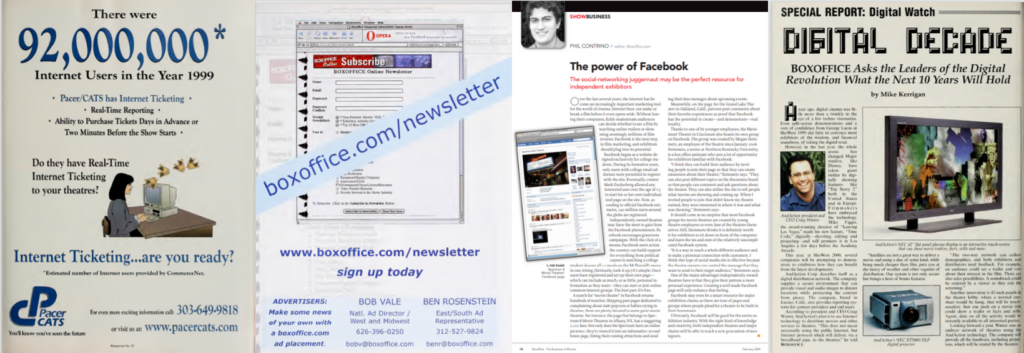
Wired World
The first revolution of the new millennium was the digital transition. The second was happening virtually, with rapid developments in online ticketing, marketing, and distribution. In June 2000, when the magazine asked Cineplex Odeon chairman and CEO Allen Karp about the future of online ticketing, he was unapologetically optimistic. “Ultimately, explosive,” he responded. “It will take time for consumers’ habits (last-minute, cash-on-the-line impulse buying) to come around, but the convenience, guaranteed fulfillment, and the evolution of e-commerce as part of our daily lives should assure success.”
The e-commerce landscape was undergoing an unprecedented competitive surge. In April 2000, in the wake of United Artists’ alliance with AOL MovieFone, AMC joined with Hollywood.com to create MovieTickets.com, an online ticketing hub that included additional editorial content from Hollywood.com’s library. Later that year, Canada’s Famous Players and National Amusements joined the endeavor as well. In 2000, just a month after the debut of MovieTickets.com at ShoWest, Regal, Loews Cineplex, Cinemark, General Cinema, Edwards, and Century—representing a combined 12,000-plus screens across North America—announced that they had joined forces to co-found their own movie ticketing website, Fandango. “Remote ticketing has really become an extension of our business, and it is critical for our business that we ensure the quality of service to all our patrons,” argued Loews Cineplex president and CEO Lawrence Ruisi. The announcement came within days of CBS’s 5 percent investment in MovieTickets.com.
Europe was also picking up on the digital ticketing trend. In Germany, for instance, Cinemaxx, UFA Theater, and Kieft & Kieft Filmtheater jointly launched a nationwide ticketing service in 2000. Back in the States, to curb the increasing power of Fandango, AOL MovieFone and MovieTickets.com partnered to create a co-branded alliance in June 2001, representing 80 percent of North American screens, that offered internet ticketing capability. AOL MovieFone transferred all its ticketing services to MovieTickets.com in 2004.
While Fandango still serviced more screens, MovieTickets.com gained exclusive rights to 32 circuits, twice that of Fandango. The e-commerce battle forced the pioneers of online ticketing to continuously innovate. “Still buying tickets online? That’s so 20th century,” wrote a Boxoffice Pro contributor in May 2006. At a time when around 6 percent of movie tickets were sold online, the next frontier was mobile. Both Fandango and MovieTickets.com expanded their services to mobile devices in the middle of the decade with an emphasis on reserved seating, concessions, and partnerships with search engines. Boxoffice Pro dedicated many pages to what was often called “DIY” or “self-serve” ticketing. In a 2001 article, Rukshan Mistry delved into the perils and possibilities of e-ticketing. “The question is not whether, but how,” he stated. The challenges, he explained, were mostly related to driving traffic to the ticketing website, especially for smaller theaters without a strong brand or the capital to operate a proper website. Customer service was also problematic because of the patron’s inability to speak directly to a person. But these concerns were overpowered by the benefits: With a clear, simple, transparent experience, e-ticketing could revolutionize the box office, cut expenses, and help theaters attract a younger, more tech-savvy generation.
Online ticketing, like interactive preshows, represented a landmark for data collection. “Typically, cinemas have known very little about their customers in the past,” said Vista’s Murray Holdaway in October 2005. “Self-service technologies in conjunction with member cards have created the ability to start to get more data on the consumer in terms of frequency, purchase patterns, etc. …” Another way to collect precious data and court younger moviegoers was through online movie marketing. Already in 2003, a TNS Media Intelligence/CMR report presented in Boxoffice Pro found that internet ad spending had surged 71.2 percent over the previous year. Marketing through exhibitors’ websites skyrocketed, while social media was beginning to pique the interest of the industry. In 2009, Boxoffice Pro wrote extensively about Facebook for the first time in the publication’s history, with Phil Contrino suggesting that the platform could help independent exhibitors build a direct relationship with their fans thanks to the possibility of online grassroots campaigns, direct messages, reviews, friend invitations, and more. Contrino wrote, somewhat prophetically: “Facebook is the next step in film marketing, and exhibitors should plug into its potential.”
The advent of the internet, however, also instilled new fears and created unique threats. Piracy was facilitated by the transmission of digital films via satellite as well as the proliferation of new platforms for online downloading. Piracy was costing the industry billions of dollars every year. NATO, the MPAA (now the MPA), and studios fought hard for legal action, as the movie industry feared that it would follow the somber example of the music industry’s battle with pirates. In an effort to prevent themselves from being “Napster-ized,” MGM, Paramount, Sony, Universal, and Warner Bros. joined forces in October 2001 to launch their own broadband service, tentatively called MovieFly, which provided consumers on-demand access to theatrically released movies. Disney and Fox responded with their model, Movies.com. In March 2007, a Boxoffice Pro writer—who had himself briefly become a pirate for the sake of journalism—concluded that “the movie industry does have to compete against piracy, but as with the music business, if it gave people what they wanted for a nicer price, it wouldn’t have to.”
This was exactly the concept that new VOD platforms capitalized on. With their emergence, the decades-old debate on windows became more urgent than ever, and sparked again in 2005—a particularly bad year at the box office—when Disney’s chairman, Bob Iger, suggested that consumers had a preference for simultaneous theatrical and DVD release. That same year, Mark Cuban—co-owner of 2929 Entertainment, which controlled Landmark Theatres—defended day-and-date releases after Steven Soderbergh’s Bubble was released in such a manner. In a November 2006 article, Cuban even argued for more studio ownership of movie theaters to eliminate the exclusivity problem altogether. NATO’s Fithian called the high-profile debate “salutary,” as it had generated media attention and precipitated discussions between exhibitors and studios.
“Thoughtful industry leaders like Howard Stringer of Sony, Sumner Redstone of Viacom, Ron Meyer of Universal, and Jim Gianopulos of Fox have all articulated publicly their support for the theatrical release window because they know the tiered release model best serves their companies and their consumers,” Fithian declared in April 2006. Filmmakers like Jonathan Demme and Tim Burton also expressed their support for longer windows. In a tribute to the cinematic art at ShowEast in 2005, M. Night Shyamalan movingly defended longer windows: “When I sit down next to you in a movie theatre, we get to share each other’s point of view. We become part of a collective soul. That’s the magic in the movies. If [simultaneous release] happens, you know the majority of theaters are closing.”
By 2007, the theatrical-to-DVD window had stabilized to four months and 16 days. But the questions raised by VOD platforms were far from resolved. “Suddenly, the talked-about place to see a movie isn’t the mall plex or old-town indie cinema. It’s on your computer—or in your hand,” lamented Boxoffice Pro’s Annlee Ellingson in November 2006. A year later, the trend had gathered more steam: “In an era in which Google has entered the lexicon as a verb, MySpace is a popular social destination, and YouTube acts as an egalitarian showcase for budding filmmakers, it should come as little surprise that the internet has emerged as the next-generation film distribution platform with most potential—if yet, unrealized,” she remarked. iTunes, Xbox Live Marketplace, and Amazon Unbox were all considered to have this kind of potential. A particular production company, Red Envelope Entertainment, and its distribution arm, Netflix, caught the interest of Boxoffice Pro. Anticipating one of the most important debates of the next decade, Chad Greene noted in April 2007: “If alternative distributors like Red Envelope have their way, more and more film fans will realize they do, indeed, live in a distribution democracy—one in which they can cast their votes either at home or at the box office.”

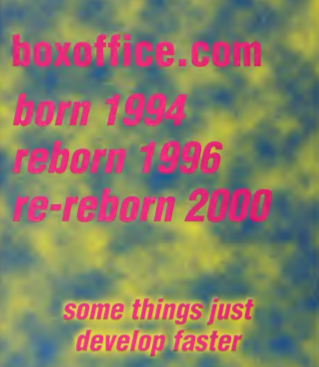

Share this post